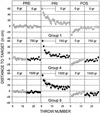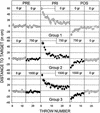Learning motor synergies makes use of information on muscular load
- PMID: 10940319
- PMCID: PMC311333
- DOI: 10.1101/lm.7.4.193
Learning motor synergies makes use of information on muscular load
Abstract
Prism adaptation, a form of procedural learning, requires the integration of visual and motor information for its proper acquisition. Although the role of the visual feedback has begun to be understood, the nature of the motor information necessary for the development of the adaptation remains unknown. In this work we have tested the idea that modifying the arm load at different stages of the adaptation process, and the ensuing change of motor information perceived by the subjects, would modify the final properties of the adaptation. We trained a set of subjects to throw balls to a target while wearing prism glasses and varied the weight of their arms at different time points during the task. We observed that the acquisition of the adaptation was not affected by the change in load. However, its persistence (i.e., the aftereffect) was reduced when tested under a weight condition different from the training trials. Furthermore, when the training weight conditions were restored later during testing, a second, late aftereffect was unmasked, suggesting that the missing aftereffect did not disappear but had remained latent. Our results show that the internal representation of a motor memory incorporates information about load conditions and that the memory stored under a specific weight condition can be fully retrieved only when the original training condition is restored.
Figures






References
-
- Cohen HB. Some critical factors in prism adaptation. Am J Psychol. 1966;79:285–290. - PubMed
-
- Ghez C. The control of movement. In: Kandel ER, Schwartz JH, Jessell TM, editors. Principles of neural science. 3rd ed. Norwalk, CT: Appleton & Lange; 1991. pp. 533–547.
-
- Hardt ME, Held R, Steinbach MJ. Adaptation to displaced vision: A change in the central control of sensorimotor coordination. J Exp Psychol. 1971;89:229–239. - PubMed
MeSH terms
LinkOut - more resources
Full Text Sources
